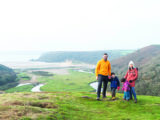As we stand on the long finger of sand extending out from the rocks, waves gently lapping at our feet and the early afternoon sun warming our faces, it’s hard to believe we are in Wales at the end of November.
Then again, give the way of the world right now, it’s hard to believe that we are anywhere other than at home.
At a time when travel is very much a luxury, we would have settled for simply being away – to be blessed with weather better suited to spring is a real bonus. We had always planned to make the most of our motorhome and travel throughout winter, a decision reinforced during both rounds of lockdown, although perhaps we had not envisaged being quite so close to home. At least that meant picking somewhere to go wasn’t as difficult as it has been in the past.
There were a few options in the running, but the very mention of medieval castles, ancient shipwrecks and smugglers’ caves was enough to tip the scales in favour of a weekend in the Gower. Needless to say, our son, Harrison, was even more excited than usual when we picked him up in the motorhome from the school gates on Friday afternoon and set off for the coast, with the promise of adventures in the footsteps of some folklore legends.
Travelling along the M4, it’s easy to keep going past Swansea, as we have done on countless occasions, but in doing so, you forget that some of the UK’s finest stretches of coast are contained within the small pocket of land that juts out into the water past Swansea Bay.
While new to us, its beauty has long been known and widely recognised, having been designated the first Area of Outstanding Natural Beauty in the UK back in 1956.
Head for the horizon
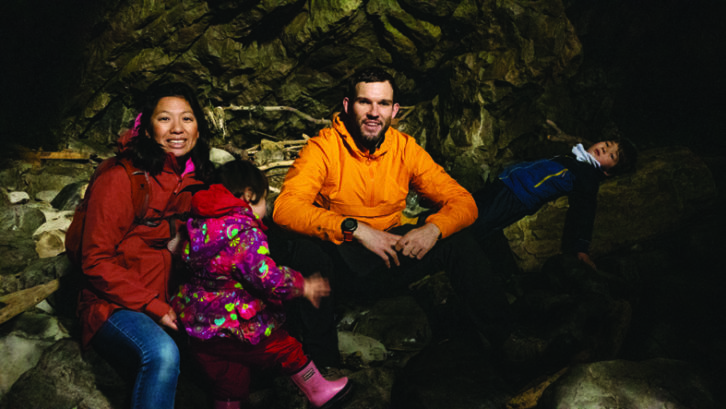
Once through Swansea, we picked up the winding coast road that would eventually lead us to our campsite, just as the sun was sliding off the horizon, flames of crimson setting the sky alight before a veil of darkness extinguished the last embers of the day.
There’s always a sense of suspense when you arrive somewhere in darkness, having to wait for the first light of the new day to reveal your surroundings – we all went to bed looking forward to Saturday morning.
The pitter-patter of rain on the motorhome roof woke us before day was broken, much to the disappointment of Harrison and his little sister Dorothy, who had hoped to head straight for the site’s excellent playground, having spied it on our way in the night before.
Kim and I, on the other hand, were grateful for a few lazy hours in bed drinking fresh coffee, a luxury we are rarely able to indulge in at home. Thankfully, the weather forecast we had consulted before setting off for the weekend was right, and just as we were finishing breakfast, the rain stopped, allowing us to pack up and set off in the footsteps of the smugglers who once controlled this little corner of Wales.
The days of the Gower being a smuggler’s hotbed may be long gone, but remnants of its past are still evident today, providing cause for excitement as we set off along the coastal path. Top of our list of places to find was Culver Hole. Legend has it that one-time local smuggling kingpin, John Lucas, used this immense cave as a storehouse – which is hardly surprising given how well hidden it is, nestled in a gnarled rocky cleft and covered by a 60ft honeycombed wall.
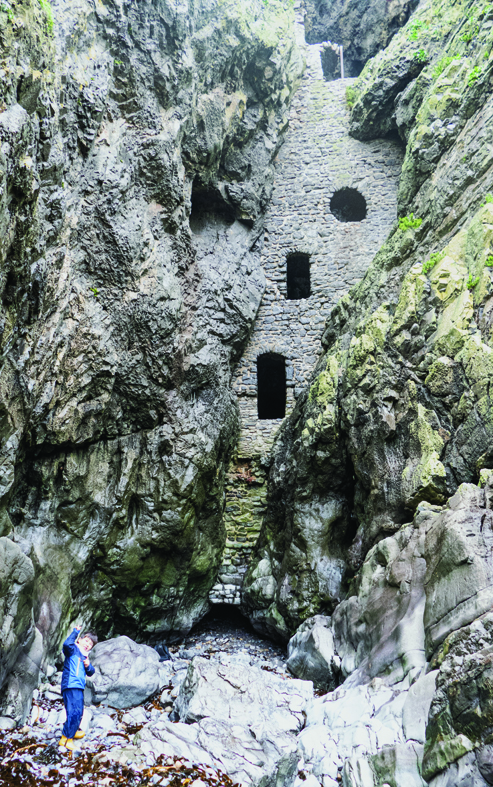
You would never know it was there unless told about it, which thankfully we had been. Even then, as we descended a path that pirouetted its way down the side of a precipitous cliff, we had our doubts. Not until we were on the small rocky beach directly in front of it was the cave actually visible. Much to Harrison’s delight, we were able to enter by crawling under the bottom of the wall, the darkness inside broken by shafts of light let in through a mismatch of windows above..
Myth has it that there’s a hidden tunnel leading back to the Salt House in Port Eynon, although after much searching, we gave up and returned to the outside world and a brisk, salty sea breeze.
Splendid isolation
The joy of being away at this time of year is that, despite the air being a little fresher and the days so much shorter, you really feel as if you’re the only people visiting. I doubt we are the only ones who, thanks to Covid, are now a little more wary of being in busy places with a lot of people about, so it was rather liberating to spend all morning walking and exploring without seeing anybody.
Another haunt for smugglers, although not nearly as well hidden, was Oxwich, which has twice been recognised as the UK Beach of the Year in more recent times. Bootleggers would often land cargo here, given its proximity to Highway Farm, which served as a major staging post for one of the area’s biggest smuggling gangs. Today it is better known for its natural beauty, with great sweeps of golden sand stretching for miles across to precipitous cliffs – the perfect playground for Dorothy and Harrison to run off their remaining energy for the day.
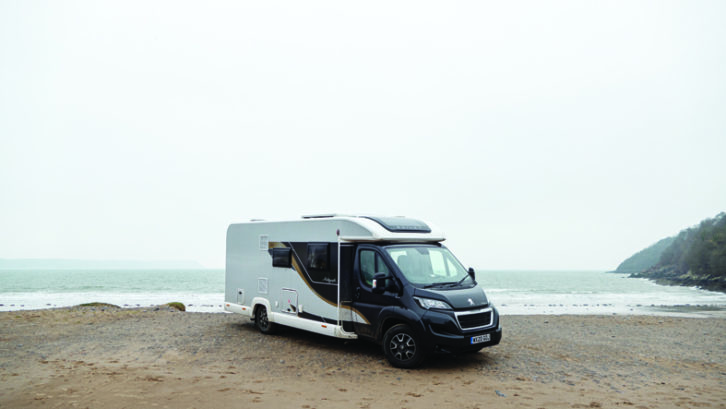
Oxwich also has the bonus of a carpark that allows you to stop on the edge of the beach, giving the sense that you are almost in the ocean when the tide is in!
Much like an army marches on its stomach, so too do lively children, and after a few hours frolicking at the water’s edge, the all-too-familiar calls of “I’m hungry!” provided us with our cue to head back to the campsite for pizza and salad.
Sunday was ushered in under a blanket of fog and a smouldering sun, lending an air of ethereal beauty to the scene as we looked out from our window down to Port Eynon Bay. With the promise of sunshine and crisp blue skies, we wasted little time, breaking camp early and heading for Three Cliffs Bay to step back in time with a visit to the ruins of Pennard Castle.
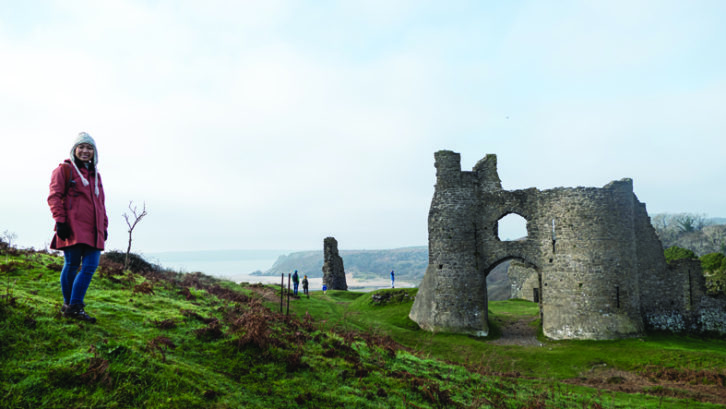
Built on the clifftop over looking Three Cliffs Bay in the 12th century, Pennard Castle went through several incarnations before eventually being abandoned because of the encroachment of the dunes; although given the multitude of folk tales and legends in the region, it’s not surprising to learn that there’s an alternative story to how the castle fell into a state of ruin.
Pennard’s lord refused to allow the fairy folk of the Gower to dance at his wedding, so they exacted their revenge in the shape of an almighty sandstorm that reduced the castle to ruins – so the story goes. Either way, the remains make for an interesting, impressive visit after a picturesque walk up through the woods, leading out onto the edge of a golf course, with views back down to the beautiful Pennard Pill (a large stream) and beach.
A quick dip in the sea
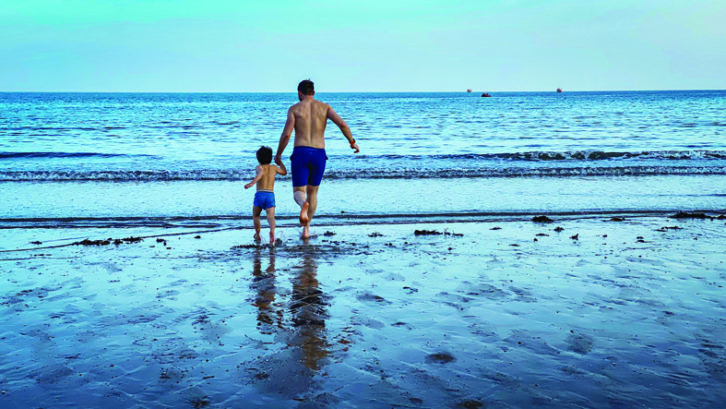
No trip to the coast would be complete without a swim in the sea, even at the end of November, so our final stop of the weekend was a return to Oxwich. This time the tide was out revealing the beach in all of its golden glory, and allowing us to explore the vast rock pools before braving the rather chilly waters.
Watching Harrison and Dorothy dipping in and out of the rock pools reminded me of my holidays as a boy further along the Welsh coast, full of excitement at turning over a rock in the hope that there would be a crab or small fishing underneath. They were not disappointed, with a wide array of sea life hiding in the pools.
I thought I’d be the only one mad enough to want to swim in the sea before heading home, but at the last minute Harrison said he wanted to join me. Needless to say, we had more than a few odd looks as we ran, hand-in-hand, straight into the water’s icy embrace. I half expected Harrison to turn around once he realised just how cold the water was, but to his credit, he came all the way in. There’s nothing quite like almost freezing water to leave you feeling alive and energised!
Two days was by no means enough time to discover all that this wonderful corner of Wales has to offer, and we know we have only touched the surface of what there is to do and see here.
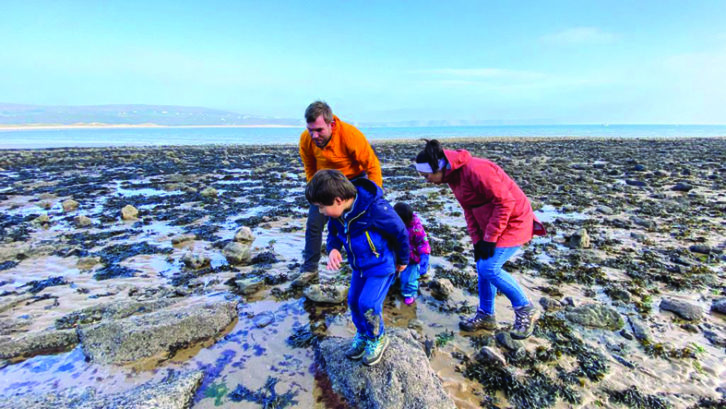
However, right now, given the lack of travel opportunities, this was the perfect antidote to a growing malady brought about by being stuck at home. It also served as a timely reminder that there’s so much beauty within our shores, something we have been made acutely aware of on several occasions this year.
Our trip has left us wondering how much of a hurry we’ll be in to go to Europe next year, when there’s still so much more of the place we call home to see. Granted, we might not always find sunshine, but in places such as the Gower, we have coast and beaches to rival any in Europe.
TOUR ESSENTIALS
WHEN TO GO
So long as you check the weather, this is a weekend break that you could enjoy all year round. Summer months will provide better weather, but will also be busier, while the winter is bound to be much quieter – and beautiful, with hard frosts.
WHERE WE STAYED
Bank Farm Leisure; Horton, Gower, SA3 1LL
FIND OUT MORE
Visit Wales (Exploring the Gower Peninsula)
If you liked this… READ THESE:
If you’ve enjoyed reading this article, why not get the latest news, reviews and features delivered direct to your door or inbox every month. Take advantage of our brilliant Practical Motorhome magazine SUBSCRIBERS’ OFFER and SIGN UP TO OUR NEWSLETTER for regular weekly updates on all things motorhome related.
Oxwich also has the bonus of a carpark that allows you to stop on the edge of the beach








